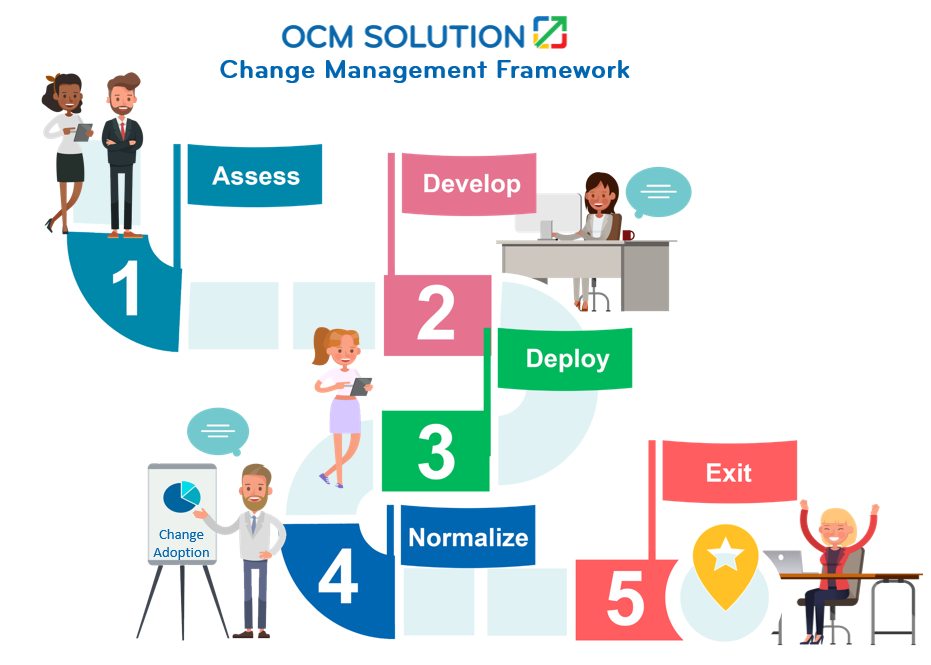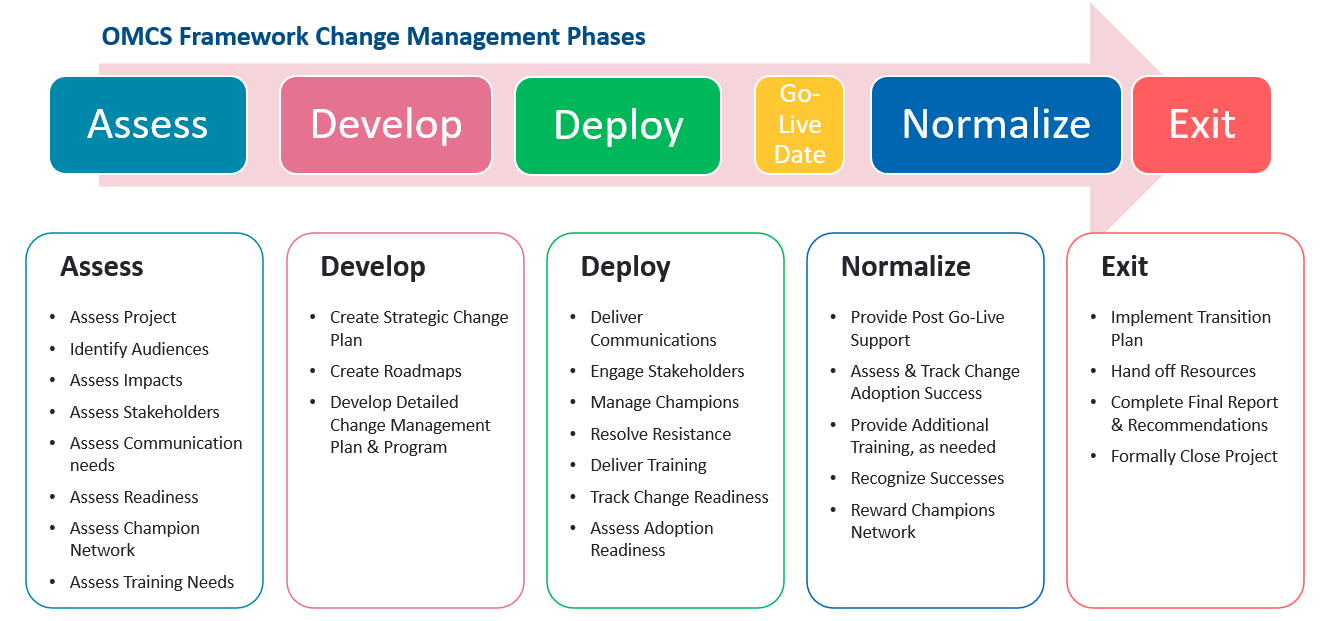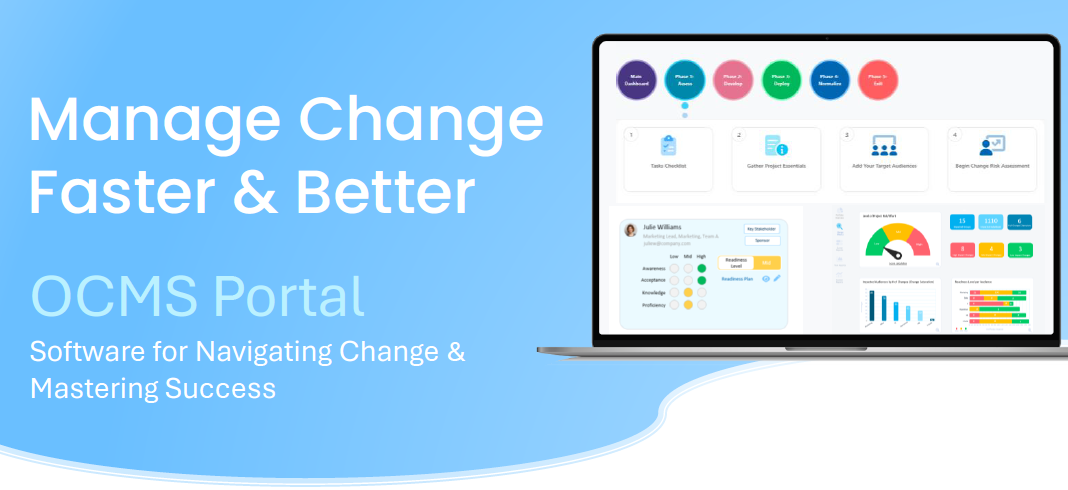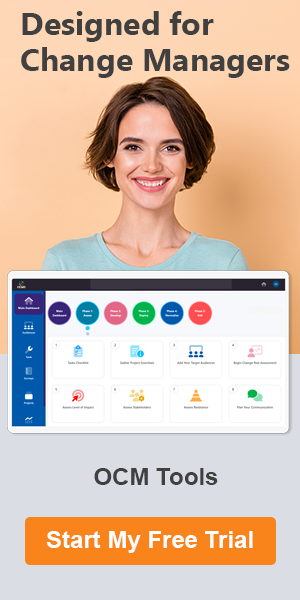Change Made Easy: Applying Practical Change Management Process and Phases
In today’s fast-paced business environment, change is inevitable. Whether it’s adopting cutting-edge technologies, reacting to market shifts, or implementing internal restructuring, organizations must continuously adapt to stay competitive. But let’s face it, managing change can feel like a daunting challenge.
The good news?
It doesn’t have to be. By applying a structured and practical change management process, navigating through transitions can become not only manageable but empowering.
So, how do you actually manage change management?
This post will walk you through a hands-on change management framework designed to help your organization thrive through transformation.
We’ll break down the complexities into actionable phases and change management steps, making the process easier and more strategic. And for those seeking efficiency, we’ll highlight software that includes built-in change management steps to streamline your journey.

Why the Right Change Management Framework Matters
Change doesn’t have to be a source of anxiety or resistance. The right change management framework provides clarity, structure, and confidence, turning uncertainty into opportunity. By following this practical framework, organizations can create a smooth, predictable path for change that engages employees and aligns with business goals.
The true value of a change management framework lies in its flexibility. It can be applied to projects of any size or complexity, ensuring that all change activities are aligned with both organizational goals and the needs of the people involved. This structured approach ultimately leads to smoother transitions, higher adoption rates, and more successful project outcomes.
Story Highlights
|
OCM Framework: A Step-by-Step Approach to Change Management
These change management steps serve as a roadmap for transformation. Each phase is designed to minimize confusion, ensure clear communication, and promote active participation from all stakeholders.
Following this process helps organizations avoid common pitfalls—such as resistance, misalignment, and lost productivity—transforming potential disruptions into opportunities for growth.
- Phase 1 – Assess: Assess and understand the project and its impacts on the organization.
- Phase 2 – Develop: Develop detailed change management strategies & plans.
- Phase 3 – Deploy: Deploy change management plan to prepare the organization for the change.
- Phase 4 – Normalize: Engage and support people to help them successfully adopt and sustain the changes.
- Phase 5 – Exit: Complete final reports, asset hand-offs, and knowledge transfers.
Within each of these change management phases are a set of key change management deliverables, plans, and strategies that need to be designed, developed, implemented, tracked, and managed based on best change management principles. They provide a clear definition of change management and give a process for managing change management.
Overview of the Change Management Process & Steps
Phase 1: Assess
This first phase involves conducting change assessments to understand the scope, scale, and impact of the project. Common assessments include:
- Project Assessment
- Target Audience Assessment
- Change Risk Assessment
- Change Impact Assessments
- Stakeholder Analysis
- Communication Assessment
- Org Readiness Assessment
- Change Champions Network Assessment
- Training / Coaching Assessment
It’s important to know that this project change management process allows for the flexibility to leave out things that aren’t needed. For example, a smaller change might not need training or a change champions network.
Phase 2: Develop
In this phase, create the strategy and plans that will guide end users through the change process. Deliverables include:
- Create OCM Strategy Playbook
- Develop a roadmap for change management process steps
- Develop the overall OCM Plan, which includes the communications plan, engagement plan, training plan, resistance management, normalization, etc.
Phase 3: Deploy
This is where the plans are executed, and the change begins to take effect. Key activities include:
- Deploying communications
- Target audience engagement (workshops, meetings, town halls, etc.)
- Training and coaching deployment
- Managing and resolving resistance
- Tracking change readiness
- Managing Change Champions Network
- Preparing for “Go-Live” adoption tracking
Phase 4: Normalize
Monitor how well employees are adopting the change, evaluate KPIs, and address any gaps. Successes and quick wins should be celebrated to reinforce momentum.
In addition, celebrating successes and quick wins are critical organizational change steps that should be implemented during this fourth phase of managing change management. These change reinforcement strategies are vital for building momentum and creating an environment where success is rewarded.
Phase 5: Exit
In the final phase, the change management team completes reports, transfers knowledge, and formally closes the project. Deliverables include:
What Projects Can Use the OCMS Change Management Strategy?
All of them!
This five-phase process can be applied to projects of any size or scope, ensuring successful change implementation. Do you have any questions about change and change management or the different stages of change management or the OCM change management procedure? Please reach out and let us know.
Understanding the Change Management Process
A Change Management Process serves as a structured approach to guide organizations through periods of transformation. This process encompasses a series of change activities designed to ensure that changes are effectively implemented, adopted, and sustained by the people impacted.
By following a well-defined change management process, organizations can break down large, complex changes into manageable steps. The five key phases—Assess, Develop, Deploy, Normalize, and Exit—each have specific OCM steps that provide a roadmap for navigating change. These steps include activities like conducting stakeholder assessments, developing communication strategies, delivering training, and managing resistance.
The benefit of using a structured change management process is that it offers clarity and consistency, reducing the chances of project delays, confusion, or resistance. When combined with the right tools, it transforms change from a potential disruption into an opportunity for improvement and growth.
The Role of a Change Management Framework
An effective Change Management Framework is the backbone of any successful change initiative. This framework provides a repeatable, scalable process that guides organizations through every stage of transformation. Each phase of the framework includes distinct OCM steps and change activities, all of which are designed to address the human aspect of change.
The change management framework ensures that key areas, such as stakeholder engagement, communication, training, and readiness, are systematically addressed. By mapping out specific deliverables and milestones at each phase, organizations can track progress, identify potential roadblocks, and maintain alignment with business objectives.
The true value of a change management framework lies in its flexibility. It can be applied to projects of any size or complexity, ensuring that all change activities are aligned with both organizational goals and the needs of the people involved. This structured approach ultimately leads to smoother transitions, higher adoption rates, and more successful project outcomes.
Do you have any questions about the stages of change management process, OCM methodology, or organizational change management process steps? Just reach out and let us know.
Change Management Software with Built-in Change Management Steps
Ensure your change management team has the software it needs to succeed in managing change management. OCMS Portal is an all-in-one change management platform that incorporates a flexible change management framework. It guides teams through a repeatable, deliverables-based change management process to achieve consistent success.
Are You an Enterprise Looking for Good Change Management Software? Our top-rated OCM software is popular with large enterprises, government agencies, and multinationals. It’s designed to scale with your needs. Smaller, local teams benefit from our affordable basic subscription plan, while large enterprises enjoy significant savings with our group discount options. (We also provide feature customization quotes!) |
Do you have any questions about the change management procedure described above? Have you been looking for a software that offers a change management process example? Please reach out. We’d love to hear from you!
Conclusion: Project Change Management Process Steps
Irrespective of the type of change that a company is implementing, it is the employees, front line managers and impacted stakeholders that have to embrace and adopt the change. Unfortunately, it is standard human nature not to like change. An employee’s comfort with the current status is extraordinarily powerful, and the uncertainty of change creates anxiety, resistance, and stress.
Why is it important to use OCM change management models for change and change management? Change management methodologies provide a structured roadmap to implement change consistently project by project. Without this foundation, it’s easy to get things wrong.
A successful project implementation for any change impacting people, includes well-proven project change management process steps that can be applied to successfully move employees from their current state to the future business state.
Many organizations try to do change management ad hoc, without any organizational change management methodology. They make the mistake of not having a clear definition of change management. This leads to several problems, such as:
- Inconsistent results
- End-users being confused about what is expected
- Difficulty tracking change management deliverables
- Inability to compare KPIs across multiple projects
Using the OCMS five change management phases provides a solid and proven process to implementing change management that is scalable and repeatable. In the following sections, we’ll discuss what these phases of change management are and explain this popular OCM change management process.
Mastering change management and how to manage change management goes beyond simply navigating the waves of transformation; it involves adopting a strategic and flexible OCM framework. As we explore the key phases of change management, it becomes clear that success hinges on thoughtfully integrating distinct steps, each reinforced with concrete deliverables and supported by a robust organizational change management framework.
The payoff of using an effective change management framework is more successful project outcomes that meet or exceed the expected ROI.
Organization change management models are crucial—they form the bedrock of transparency, accountability, and ultimately, success. Change is more than an inevitable part of organizational life; With a thorough understanding of the different stages of change management and the effective use of deliverables, organizations can confidently navigate change, leveraging it as an opportunity to innovate, evolve, and prosper.
Click below for a deep-dive review of each phase of the change management process:
FAQ – Change Management Phases & Steps
What are the 5 change management phases?
The OCM Solution change management framework and its change management steps is a comprehensive methodology. It emphasizes a “manage by deliverables” approach and is success focused. The 5 phases of change management are:
- (Phase 1) Assess: Assess and understand the project and its impacts.
- (Phase 2) Develop: Develop detailed change management plans.
- (Phase 3) Deploy: Deploy OCM support and prepare the organization for the change.
- (Phase 4) Normalize: Engage and support people to normalize the change adoption.
- (Phase 5) Exit: Complete final reporting and handoffs
What should you do in the first phase of a management of change process?
The first phase in the OCM process to manage change management involves conducting a series of change assessments to understand the scope, scale, and impacts of the change.
Why should you use structured change management steps?
Well-defined phases of change management with clear deliverables streamline the transition and foster a culture of adaptability, innovation, and continuous improvement within the fabric of an organization.
Note: Content on OCM Solution's ocmsolution.com website is protected by copyright. Should you have any questions or comments regarding this OCM Solutions page, please reach out to Ogbe Airiodion (Change Management Lead) or the OCM Solutions Team today. OCM Solution was previously known as Airiodion Global Services (AGS).
External sources: stock.adobe.com






